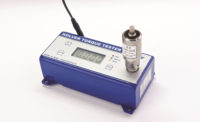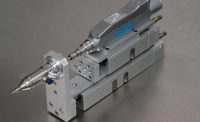Preventing screws from loosening requires the right combination of thread design, torque specification and fastening tool.

The worst Thanksgiving in John Souza’s memory happened more than 20 years ago, back when he was an engineer for the now-defunct Digital Equipment Corp. in Maynard, MA. Days earlier, the company completed assembly of a multimillion-dollar computer system, loaded it into a semitrailer, and sent it out to a Fortune 100 customer in Southern California.
The truck arrived the day before Thanksgiving, but when the trailer doors were opened, the customer received an unwelcome sight: The plastic panels that enclosed the electronics had fallen off in transit! It was not exactly what they wanted to see after spending millions on state-of-the-art technology. Holiday or no holiday, Digital quickly dispatched Souza to California to reassure the customer and learn what went wrong.
“I couldn’t understand it,” recalls Souza, now a manufacturing consultant for Quality Screw & Nut (Wood Dale, IL). “The panels were fastened with #10 screws. The standard formula called for 27 in-lb of torque, and that’s what they were tightened to.
“However, I didn’t consider how hot it would get in that trailer. To get from Massachusetts to Southern California, the truck had to pass through Texas, New Mexico and Arizona. It was 120 F inside that trailer! It was so hot that the plastic migrated away from the fasteners. All those screws that were nice and tight became loose. Once we tightened them back up, there was never a problem, but then the system was in a climate-controlled environment.”
Souza’s story is not uncommon. You develop the perfect torque specification. You invest in high-tech tools to verify every fastener is tightened to that specification. You monitor statistics to ensure your process stays on track. And yet, sometimes, assemblies still come back with loose fasteners. Often, the culprit is some environmental factor, such as thermal cycling or vibration, that engineers simply didn’t account for when designing the product or the process.
To keep fasteners from loosening, engineers need the right screw, the right torque specification and the right tool. Lock washers, threadlockers and other additions to the joint are effective in preventing loosening, experts say. However, they also add cost and time to the assembly process, and most can only be used once. Often, such extras can be avoided by choosing a more appropriate screw.
“There’s no simple answer to the problem of loosening,” notes Ken LeVey, director of global product development for ITW Shakeproof (Broadview, IL). “You have to consider the joint, the internal thread, external thread, grip length, coatings, fastener spacing, serviceability and the environmental conditions.”
Ideally, engineers would ferret out loosening problems at the design stage through torque testing and environmental stress testing. But, few manufacturers devote the resources to such work, unless the assembly is safety-critical.
“Generally, engineers don’t worry about the fasteners until the very end,” admits LeVey. “Sure, testing will identify potential problems, but it’s expensive and it takes time. The shortest path is to consult people who have years of experience with fasteners and to do it up-front-use your suppliers.”

Fastening in Metal
Vibration loosens fasteners by creating relative motion between the threads. “Imagine you’re sitting on a sandpaper slide with a weight on your shoulders,” explains LeVey. “Friction and the weight will keep you from moving. But, if you bounce, you will slowly move down the slide.” A screw is little more than a sandpaper slide wrapped around a metal shaft.Thermal cycling poses two additional mechanisms for loosening. One is through annealing-heating and cooling the fastener to the extent that the strength it received from heat-treatment diminishes. The other is through expansion and contraction, which, like vibration, causes relative motion between the threads.
Loosening due to annealing can be prevented by choosing the right grade of fastener to match the expected temperatures. Loosening from vibration, expansion and contraction can often be prevented just by ensuring the right amount of clamp load is applied to the joint. When tightening a screw, the goal is to stretch the fastener to its yield point, without going over, says LeVey.
In other cases, engineers need a fastener that will maintain clamp load in spite of vibration and thermal cycling. One such fastener is the Sinuloc from ITW Shakeproof.
In most threaded fastener assemblies, space exists between the screw threads and the mating threads. When subjected to shear force or vibration, this space allows the screw to move in the path of least resistance. The Sinuloc threads eliminate this space. By simultaneously pushing on both the pressure and the trailing flanks of the joint, the fastener creates prevailing tension within the joint itself. The fastener can be installed in standard tapped holes without damaging the mating threads, and it can be installed and reinstalled repeatedly.
“Sinuloc is like being in a hallway with your shoulders stuck between the walls. You can’t move left or right,” says LeVey.
Loss of clamp load due to thermal cycling is more problematic when driving into light metals, such as magnesium and aluminum, than when fastening steel. That’s because light metals have different rates of thermal expansion than the steel screws.
To counter this, suppliers have designed screws specifically for aluminum and other light alloys. One example is the ALtracs thread-forming fastener from Semblex Corp. (Elmhurst, IL). The fastener’s threads have a 33-degree asymmetrical flank angle, which equalizes the strength ratio between the steel screw and the mating boss. This is achieved through balancing the cross-sectional area of the thread to reflect each material’s strength characteristics.
The thread-forming zone consists of a tapered, noncircular point with thread-forming relief flats. The taper helps assemblers insert and align the fastener in the hole. It also decreases the amount of torque needed to start the thread-forming process. The flat areas in the zone provide relief during thread-forming, reducing driving torque by approximately 30 percent.
The screw’s circular cross section maximizes thread engagement compared with trilobular screw designs, providing high stripping torques, consistent vibration resistance and superior clamp-load generation.
“The ALtracs fastener prevents loss of clamp load due to vibration and thermal cycling,” says Gene Simpson, director of engineering services for Semblex.
The fastener can be removed and reinstalled multiple times, or it can be replaced with a standard metric machine screw. The fine pitch of the threads maximizes engagement with the mating material, so engineers can use shorter fasteners and smaller bosses than with standard fasteners.

Fastening in Plastic
The central problem when fastening plastic is that, well, it’s plastic. It flexes and flows. “As soon as you remove the tool, the material starts to relax,” says Simpson.To counteract that, engineers need fasteners specifically for plastics, such as the Delta PT from Semblex. The flank geometry of the fastener reduces radial stress on the boss. The flank starts with a 30-degree angle that quickly backs off into a 20-degree angle. This permits unimpeded flow of the plastic during installation.
The multi-angled thread profile and cored recess of the fastener maximize engagement with the plastic. Fasteners with a flat root can cause material to jam, which can concentrate stress in the plastic and lead to cracking. The cored root eliminates stress concentrations and provides nearly 100-percent flank engagement.
The head of the Delta PT has a large bearing surface, which distributes pressure over a wide area of the boss. It also enhances joint stability by reducing creep and increasing break-loose torque. The increased minor diameter and large cross sectional area of the Delta PT boost torsional and tensile strength, so the fastener can be used in thermoset and glass filled thermoplastic materials.
“You want the fastener to engage as much surface area as possible to hold the load,” says Simpson.
Another option is the BosScrew from ITW Shakeproof. The threads of this screw have tiny notches on the upper surfaces. The plastic flows into these notches, mechanically locking the thread with the material and greatly increasing resistance to loosening. The notches are inactive during installation, and the screw can be removed and reinstalled.
“The BosScrew is like a car parked between speed bumps,” says LeVey. “You can drive over them, but if you’re parked between them, you’re not going to move if you rock the car back and forth.”
Even with a screw for plastics, engineers still need to set the right torque specification. Looking back on the problem of fastening the panels for the computer system, Souza later realized that the standard formula he used to determine the torque was more appropriate for steel than for plastic.
“The formula is based on the root diameter of the screw and the point at which the shaft will elongate,” he explains. “That won’t work in plastic, because the screw never gets into the elastic range. After all, plastic is only one-tenth as strong as steel.”
When fastening plastic, friction between the threads and the material is more important to maintaining clamp load than the spring-like action of a stretched shaft. “If you overtorque the screw, the plastic will migrate away from the load as soon as it’s exposed to heat,” says Souza. “You have to lower the torque with softer materials. If the formula calls for 14 in-lb of torque in steel, you may need 5 or 6 in-lb in plastic. Finding the optimal torque will require some testing.”
Just as important as setting the right torque is using a tool that will apply it accurately. Here, too, the primary concern is to avoid overtightening the screw. “When fastening into plastic, you have to increase the sophistication of the tool,” Simpson says. “If the torque is all over the map, you won’t have control over the process.”



